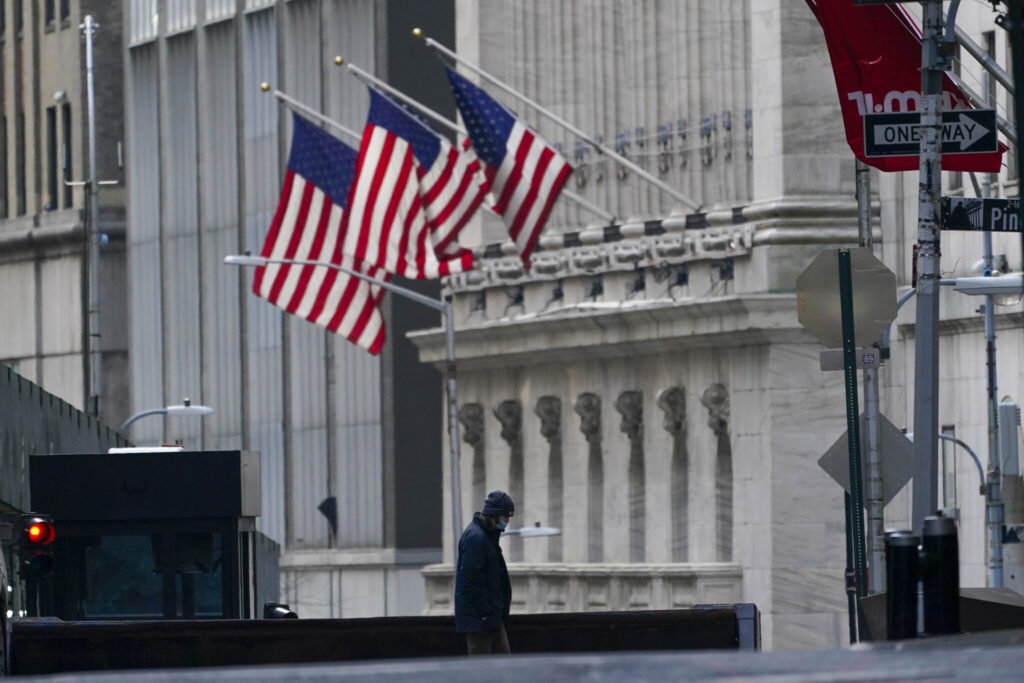After an initial sell-off, stocks have regained some ground over the course of morning trading on Thursday but remain mostly lower. The major averages have all pulled back after turning higher over the course of the previous session. The Associated Press has the story:
Wall Street sinks on worries about high inflation
Newslooks- NEW YORK (AP)
Stocks are sinking on Wall Street Thursday on worries that inflation is remaining hotter than feared.
The S&P 500 was 1.1% lower in morning trading after a report showed inflation at the wholesale level slowed by less last month than economists forecast. It echoed a report on prices at the consumer level from earlier this week that suggested inflation isn’t cooling as quickly and as smoothly as hoped.
The Dow Jones Industrial Average was down 370 points, or 1.1%, at 33,759, as of 10:08 a.m. Eastern time, while the Nasdaq composite was 1.1% lower.
Stocks have been churning recently as worries about sticky inflation joust against data suggesting the economy remains more resilient than feared. The worry has been that persistently high inflation will push the Federal Reserve to get even more aggressive on interest rates. Higher rates can drive down inflation but also drag on investment prices and raise the risk of a serious recession.
Such fears have been most clear in the bond market, where yields have leaped this month as traders up their bets for how high the Fed will take interest rates this year.
The yield on the two-year Treasury, which tends to track expectations for Fed action, jumped to 4.67% from less than 4.60% before the inflation report’s release and from less than 4.10% earlier this month. It’s near its highest level since November, when the yield reached levels last seen in 2007 before the Great Recession.
The 10-year Treasury yield, which helps set rates for mortgages and other loans, rose to 3.85% from 3.80% late Wednesday.
Thursday’s report showed that prices at the wholesale level were 6% higher last month than a year earlier. While that was a slowdown from December’s 6.5% inflation rate, it was worse than the 5.4% that economists expected to see. Perhaps more alarming was that inflation accelerated in January on a month-to-month basis even after stripping out prices for food, energy and other layers.
The inflation report thudded onto Wall Street along with a batch of other data painting a mixed picture of the economy.
Fewer workers applied for jobless benefits last week than expected, a sign that layoffs remain low across the economy. That’s good news for workers and another signal of strength for the job market, but the Fed worries it could also add upward pressure on inflation.
Other reports, meanwhile, showed an index of manufacturing activity in the mid-Atlantic region plunged this month, while homebuilders broke ground on fewer homes last month than economists expected.
Altogether, the reports added doubt to the hopes on Wall Street that the Federal Reserve could pull off the tightrope walk of slowing the economy just enough to stamp out inflation but not so much that it creates a severe recession.
The Fed has already hiked its key overnight rate up to a range of 4.50% to 4.75%, up from basically zero a year ago. It has said that it expects to push through a couple more increases before holding rates at a high level at least through the end of this year.
The strong recent reports on inflation and the job market have forced Wall Street to align its forecasts for rates closer to the Fed’s. Earlier this year, there was a wide disconnect between them. Investors were betting the Fed wouldn’t go as high as it was saying, while also holding out significant hopes for a cut to rates in the latter part of the year.
The fear now is that if inflation proves sticker than expected that the Fed will have to go beyond what it’s been prepping the market for.
Loretta Mester, president of the Federal Reserve Bank of Cleveland, said in a speech Thursday that she saw “a compelling economic case” at the Fed’s meeting earlier this month to raise rates by double what it ended up doing. The Fed on Feb. 2 raised its key overnight rate by 0.25 percentage points, the latest downshift in its size of increases from earlier hikes of 0.50 and 0.75 points.
Some stocks on Wall Street were able to buck the overall downward trend after reporting stronger earnings for the latest quarter than expected. Networking giant Cisco Systems rose 5%, and waste services company Republic Services gained 1.6%, for example.
Big tech stocks were helping to lead the overall market lower, though, because they’re seen as some of the most vulnerable to higher interest rates. In earlier years, their stocks shot higher in part because of record-low interest rates.
A 1.3% fall for Microsoft, 2.6% drop for Nvidia and 1.9% slide for Amazon were some of the heaviest weights on the S&P 500.







